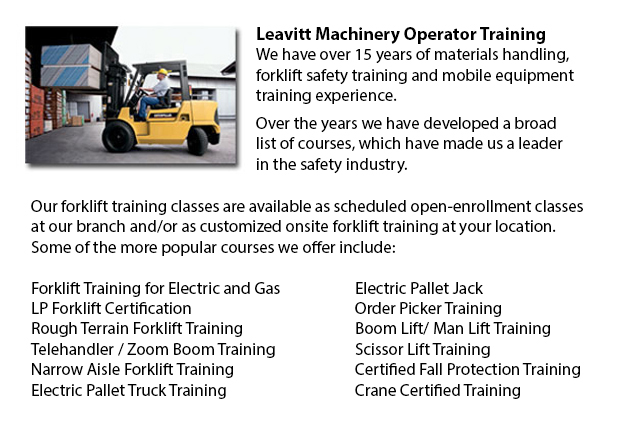
Rough Terrain Forklifts Training Vaughan - There are in actual fact two unique categories of lift trucks within the materials handling industry, the industrial model and the rough terrain model. Rough terrain forklifts initially arrived on the marketplace in the 1940's and were predominantly used on rough surfaces, best for areas where no paved surfaces were existing, like building sites and lumberyards.
Rough ground forklifts generally employ an internal combustion engine with a battery for power. The engines can function on propane, diesel or gasoline. Several manufacturers are playing with rough ground forklifts that make use of vegetable matter and run from ethanol. Huge pneumatic tires with deep treads typify these forklifts to permit them to latch onto the roughest ground type without any slippage or shifting.
Some of the original designs of rough terrain lift trucks had the ability to haul in excess of 1000 lbs, via forks that could run underneath the item, jack it marginally and shift it to another site. After ten years on the market, all terrain lift trucks were enhanced with supplementary hauling power, increasing the possible load to more than 2000 lbs. Telescoping booms were added in the 1960's, allowing them to stack materials a great deal higher than in earlier years. The telescoping model characteristic is a staple of most rough terrain lift trucks nowadays. Present models are capable of managing well over 4000 lbs due to the continued enhancements over the years. Telescoping capability has additionally improved with some models reaching a height of 35 feet. Operator safety has also become a focus with many rough terrain lift trucks now developed are equipped with an enclosed cab for the operator, as opposed to the older open air seating capacity.
The rough terrain lift trucks accessible today work equally as well on paved floors as on unpaved surfaces. These rough terrain forklifts are being marketed for their usefulness allowing businesses to move items from outside the plant to the inside or vice versa.
-
Nissan Forklift
Nissan Forklift Training Vaughan - Nissan Motor Co. Ltd prides itself on reaching complete client contentment when enjoying one of their car, truck or forklift products. They are fully committed to providing high value and detail-oriented quality val... More -
Pallet Lifts
Pallet Lifts Training Vaughan - A pallet lift is a model of equipment focused in the maneuvering of pallets of many dimensions and weights. They can be utilized as an appendage for forklifts, cranes and other types of heavy machinery or be used on th... More -
Boom Lifts
Boom Lifts Training Vaughan - Boom Lifts are a platform lift mechanism that could be raised or lowered to varying heights, making this equipment a useful instrument for various industrial uses. There are some different variations of Boom Lift consist... More -
Scissor Pallet Trucks
Scissor Pallet Truck Training Vaughan - Scissor lift pallet vehicles are built to have the ability to transport and stack pallets with a built-in raising mechanism that allows the pallets to be elevated. This equipment is incredibly useful for worki... More -
Toyota Forklift
Toyota Forklift Training Vaughan - Since 1992, Toyota Material Handling inc., U.S.A., often known as TMHU, continues to be the top selling lift truck dealer in the United States. This business has been based out of Irvine, California for well over 40... More

Forklift Training Vaughan
TOLL FREE: 1-888-254-6157
Vaughan, Ontario
forklifttrainingvaughan.com
Email Us
About Us


